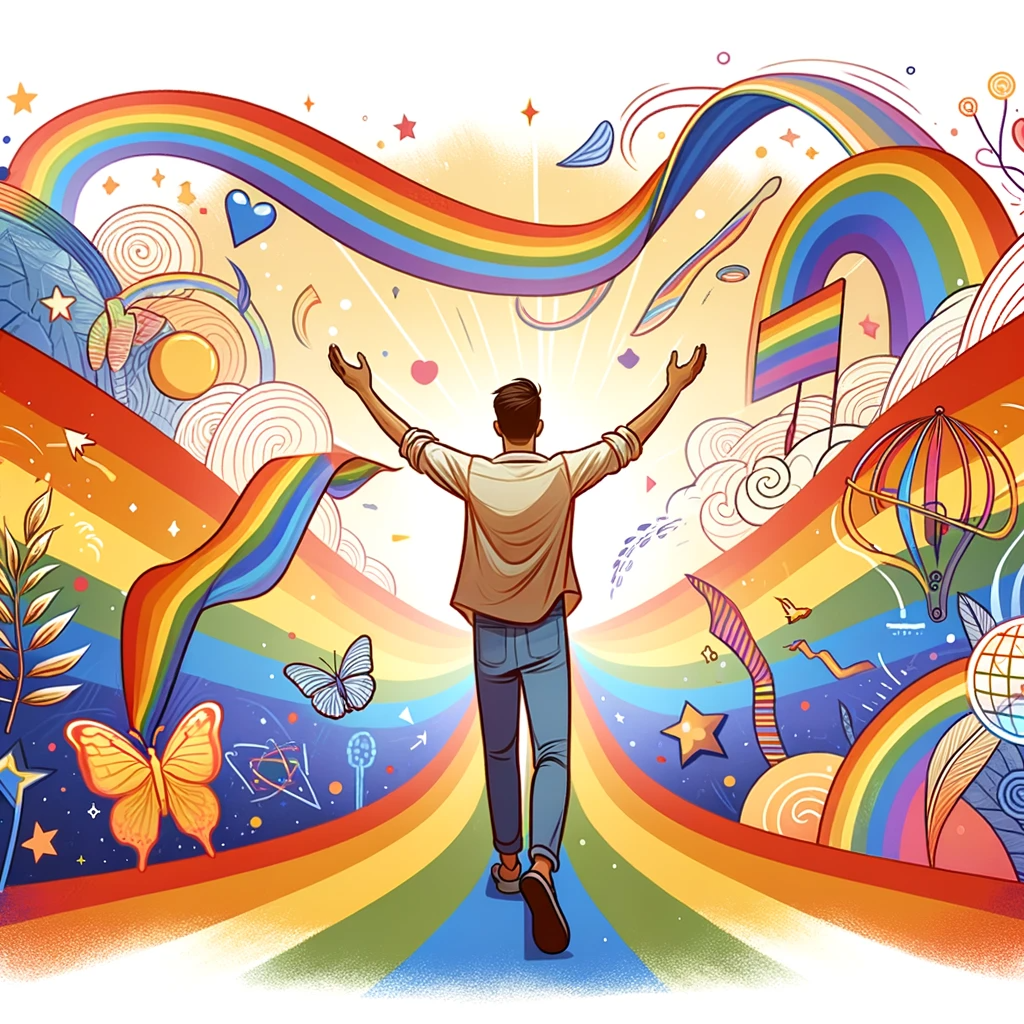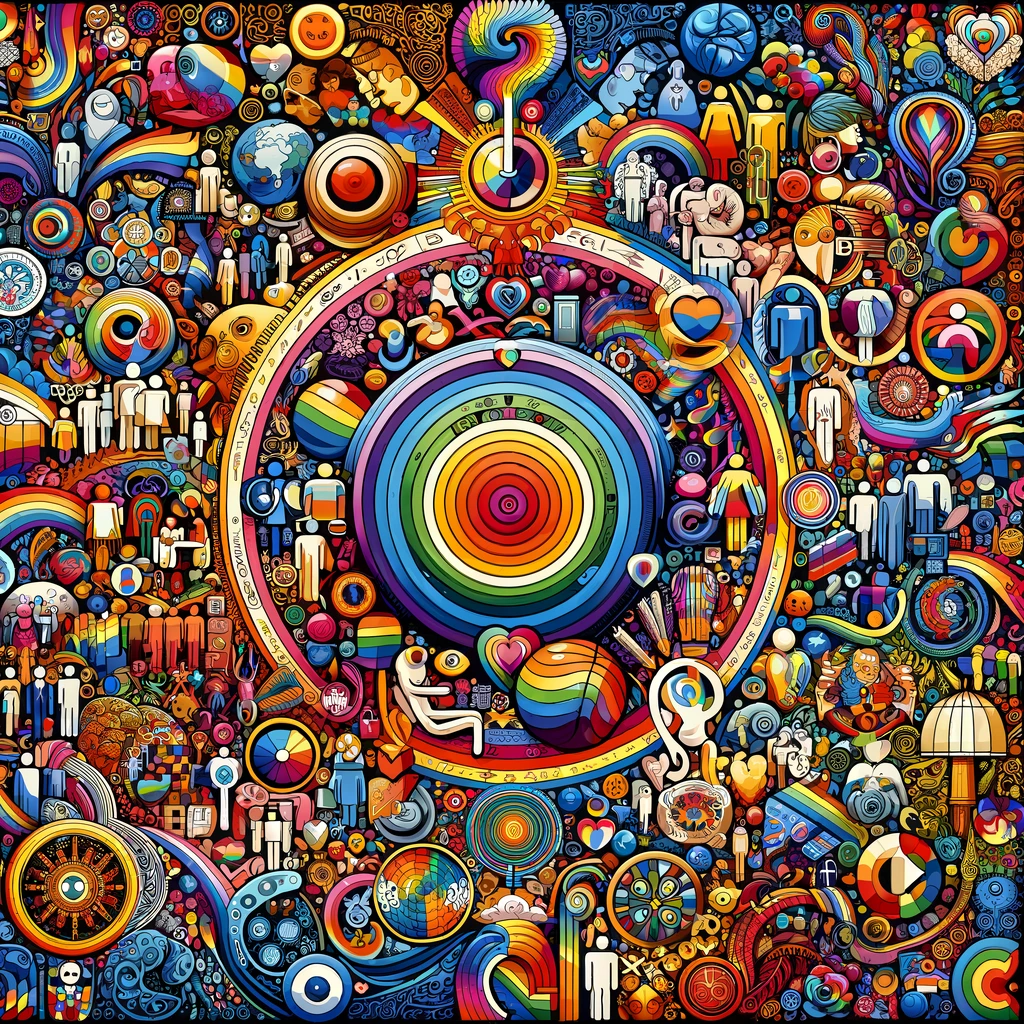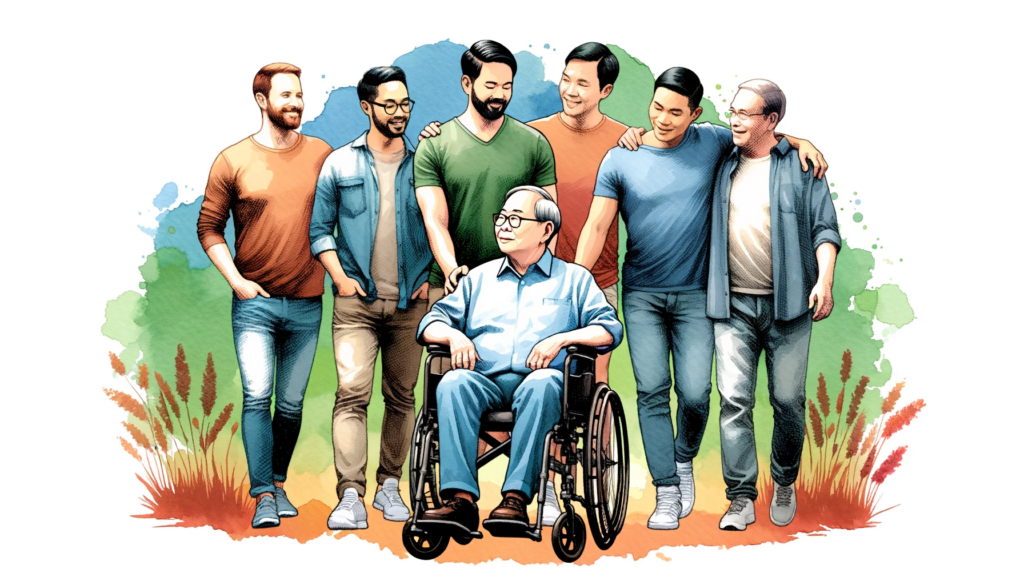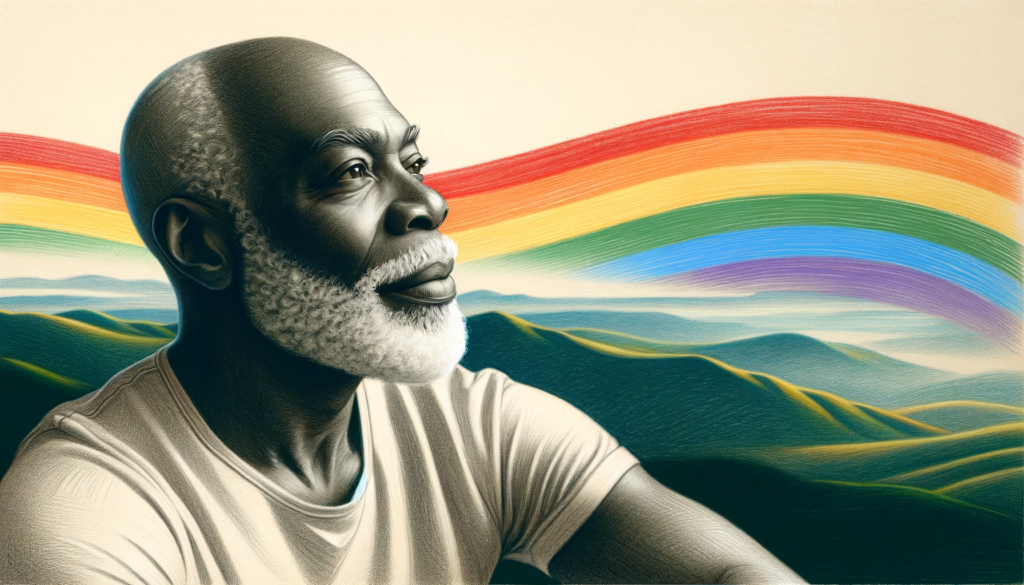
In this post, I want to explore a topic close to my heart and my work: the exploration of identity and self-acceptance in the gay community. This subject is not just about understanding who we are but also about embracing and celebrating our unique selves in a world that often presents more questions than answers.
In the gay community, the quest for personal identity can be a road paved with challenges, yet it is also one marked by profound personal growth and self-discovery. Each individual’s journey is a complex tapestry woven from their experiences, struggles, and triumphs. As we navigate these paths, we learn not just to accept ourselves but to revel in the beauty of our authentic identities.
In this blog, we’ll explore the nuances of identity within the gay community, the hurdles that often stand in the way of self-acceptance, and the remarkable resilience that propels us forward.
So, whether you’re taking your first steps towards self-acceptance or you’re further along this road, I invite you to join me in this exploration. Together, let’s discover how embracing our true selves can lead to a life of richness and authenticity.
Before I go further – the difficulties of using the term “Gay Community”
In my work as a counsellor, I’ve often encountered the term ‘gay community’ used as a broad descriptor. While it serves as a convenient label, there is a lot complexity and diversity that lies beneath this umbrella term. The gay community is not a monolith; it is a vibrant tapestry, rich with varied experiences, identities, and backgrounds.
This diversity is something to celebrate, yet it also presents a challenge. When we speak of the ‘gay community’, we risk oversimplifying and overlooking the nuances of individual experiences. Within this community, there are countless stories, each coloured by factors such as cultural background, race, age, socio-economic status, and gender identity. These intersectional aspects play a significant role in shaping each person’s journey and their experience of both acceptance and discrimination.
For instance, the experience of a young gay man from a metropolitan city can be vastly different from that of an older individual living in a rural area. Similarly, the challenges faced by a gay person of colour will not entirely align with those encountered by their white counterparts.
By being aware of the challenges that some hold about the term ‘gay community’, we open up a space for dialogue and learning. It encourages us to look beyond the generalizations and to see the individuals – each with their unique story and struggle. This perspective is vital for building a truly inclusive and supportive environment, one where every voice is heard, and every experience is acknowledged.

So, even though I will use the term ‘gay community’ please know that I hold in mind that there isn’t a monolythic single community but that I believe that certain experiences are often shared by many gay men.
Historical Context and Evolution of Identity
The diverse historical contexts that shape the identities of those in the gay community form a narrative of contrasting experiences: while there has been significant progress in many parts of the world, challenges and setbacks remain prevalent, particularly in regions where acceptance is far from reality.
The journey towards rights and recognition has been uneven globally. In Western countries, the latter half of the 20th century marked a shift towards greater acceptance. The Stonewall riots in 1969, for example, catalyzed the modern gay rights movement, propelling issues of the gay community into the public consciousness. Legal strides like the decriminalization of homosexuality in England and Wales in 1967 set a precedent for change, albeit slowly.
However, this progress was not linear or universal. The AIDS crisis in the 1980s, for instance, triggered a resurgence of homophobia, affecting public perception and individual self-esteem within the gay community (Shilts, 1987). The crisis underscored the fragile nature of societal acceptance, which could be easily upended by fear and misinformation.
In contrast, many African countries and regions like Russia continue to grapple with severe legal and societal challenges. Homosexuality remains criminalized in numerous African nations, compounded by cultural stigmatization and lack of legal protection. In Russia, the ‘gay propaganda’ law passed in 2013 has further marginalized the gay community, curtailing rights to expression and assembly. These contrasting global landscapes highlight the varying degrees of progress and regression in the journey towards acceptance and recognition.
Moreover, recent years have seen a troubling trend in some Western countries where LGBTQ+ rights, once thought secure, are being questioned or threatened. This regression is a stark reminder that the path to acceptance is not only non-linear but also susceptible to political and social shifts. The rise of conservative movements and anti-LGBTQ+ rhetoric in politics and media has created an environment where hard-won rights and acceptance are under threat, impacting the sense of security and identity within the gay community.
This complex historical tapestry influences how individuals in the gay community form and perceive their identities. The strides in acceptance and rights in some regions provide hope and a framework for advocacy, while the challenges in others serve as a sobering reminder of the work still needed. This reminds us that the journey of self-acceptance and identity formation within the gay community is shaped by a myriad of societal, cultural, and political factors.
The Journey of Self-Acceptance

In my years as an online counsellor, I’ve witnessed firsthand the complex journey of self-acceptance that many in the gay community navigate. This path is often strewn with obstacles such as societal pressure, internalized homophobia, and mental health challenges. Understanding and overcoming these barriers is crucial for embracing one’s identity.
Societal Pressure and Its Impact
Societal norms and expectations can exert immense pressure on individuals in the gay community. From the media’s portrayal of sexuality to cultural and religious norms, these external influences often dictate how individuals should think, feel, and behave.
The pressure to conform can lead to a sense of alienation and the fear of being ostracised. I’ve seen many clients struggle with balancing their true selves against the expectations set by their families, peers, and society at large.
Internalized Homophobia: The Silent Battle
Internalized homophobia, a term that refers to the internalization of societal stigma, is another significant obstacle. It manifests in various forms, from self-doubt and negative self-talk to outright denial of one’s sexual orientation. This internal conflict can be deeply damaging, leading to a fractured sense of self and hindering the journey to self-acceptance.
Mental Health Challenges
The mental health challenges that arise from these pressures are profound. Studies have shown that individuals in the LGBTQ+ community are at a higher risk of experiencing mental health issues, including anxiety, depression, and substance abuse, compared to their heterosexual counterparts. This heightened risk is a direct consequence of the societal and internal challenges faced by the community.
Strategies for Embracing Identity
Despite these challenges, there are strategies and resources available to support the journey of self-acceptance:
Seeking Professional Support: Engaging with a counsellor or therapist, especially one who specializes in LGBTQ+ issues, can provide a safe space to explore and understand one’s identity. Therapy can be a powerful tool in addressing internalized homophobia and building self-esteem.
Building a Supportive Community: Connecting with others who share similar experiences can be incredibly validating. Whether it’s through local support groups, online forums, or LGBTQ+ events, finding a community can reduce feelings of isolation and provide a sense of belonging.
Self-Reflection and Acceptance Practices: Engaging in self-reflection through journaling, mindfulness, and other self-acceptance practices can help in understanding and embracing one’s identity. It’s about creating a dialogue with oneself that is compassionate and affirming.
Educational Resources: Educating oneself about the diversity and history of the gay community can foster a sense of pride and belonging. Reading books, watching documentaries, and attending workshops can be enlightening and empowering.
Self-Care: Prioritizing self-care is crucial. This can include regular exercise, maintaining a healthy diet, getting enough sleep, and engaging in activities that bring joy and relaxation. Suggestions for how to cultivate self-care.
Mental Health Resources
There are also several mental health resources available:
LGBTQ+ Specific Mental Health Services: Many organizations offer counselling and support specifically tailored for the LGBTQ+ community. Some examples include:
Helplines and Online Support: Helplines and online forums can provide immediate support and guidance. For instance:
The journey to self-acceptance is deeply personal and can be challenging, but remember that it’s also a journey of empowerment and growth.
The Role of Community and Support Systems
The journey towards self-acceptance and identity in the gay community is often significantly influenced by the presence of supportive communities and systems. These communities play a vital role in several ways:
- Providing a Safe Space: Community groups and support systems offer a safe haven where individuals can express themselves freely, without fear of judgment or discrimination. This is especially important for those who may not find acceptance in their immediate family or social circles.
- Fostering Connection and Belonging: Feeling isolated is a common experience for many in the gay community. Supportive communities help mitigate this by providing a sense of belonging and connection. They offer a platform to meet others with similar experiences, fostering friendships and networks that can be life-changing.
- Empowerment Through Shared Experiences: Sharing stories and experiences with others who have faced similar challenges can be incredibly empowering. It helps individuals realise they are not alone in their struggles, which is a powerful component of the healing and acceptance process.
- Access to Resources and Information: Community groups often provide access to a wealth of resources, including mental health services, legal aid, and educational materials, which can be invaluable for individuals navigating their journey.
- Advocacy and Representation: Communities often serve as advocates for the rights and needs of their members, fighting for recognition, acceptance, and equality. This advocacy is crucial in bringing about societal change and acceptance.
Examples of Communities for Gay Men
Loving Men+
Loving Men+ in the UK is a shining example of how such communities can foster deep connections and personal growth. They provide events and resources for gay, bi, trans men, non-binary people, and those who wish to explore intimacy and experience a stronger sense of community. Their events, which they describe as ‘adventures in intimacy,’ offer opportunities to step outside of comfort zones, make connections, and probably “laugh harder than you have for a long time”. They welcome individuals from all walks of life, encouraging participation from diverse groups, including black and ethnic minority men, HIV positive and negative men, young and older men, trans men, and disabled men.
Stretch Festival in Berlin
Stretch Festival in Berlin, another vibrant example, is a weekend festival for gay, bi, trans, queer men, and those on a gender-fluid male-to-non-binary spectrum. The festival welcomes individuals from all backgrounds and identities, creating a space that transcends the typical confines of queer masculinities. Their diverse program includes bodywork, mindfulness, art, movement, sexuality, psychology, spirituality, and more. Participants can choose from 36 workshops, talks, and experiential explorations, fostering a soulful and playful connection to one another and life itself.
The Importance of Digital Spaces
In addition to these physical spaces, digital platforms have become increasingly crucial, especially for those who may not have access to physical LGBTQ+ spaces. Online forums, social media groups, and virtual events provide safe spaces for people to connect, share experiences, and find support. These digital platforms are particularly important for individuals in regions where the LGBTQ+ community is less accepted or visible.
A Global Perspective
While focusing on examples from the UK and Berlin, it’s important to acknowledge the global landscape. In countries where being part of the LGBTQ+ community is still stigmatised or criminalised, online communities can be a lifeline, offering support, information, and a sense of belonging. They bridge geographical barriers, allowing for a global exchange of ideas and experiences, which is invaluable for personal growth and acceptance.
Personal Growth and Self-Discovery: Embracing the Spectrum of Gay Identity
In the journey of personal growth and self-discovery within the gay community, one of the most intriguing aspects is the exploration of how we choose to identify ourselves. The gay community, diverse and multifaceted, offers a plethora of identities, often categorised by sexual preferences, appearance, hobbies, or even certain kinks. These ‘tribes’, such as bears, twinks, leather enthusiasts, among others, provide a sense of belonging and identity. However, this segmentation, while sometimes empowering, can also present challenges.
The Complexity of Gay Identity Tribes
Navigating these tribes requires a delicate balance. On one hand, they offer a framework to understand and express our sexuality and personality. For instance, the leather community, often associated with a particular style of attire, represents more than just a fashion choice. It embodies a culture with its own norms, values, and social dynamics that may include, but are not limited to, expressions of masculinity, power dynamics, and specific sexual preferences. This community, like others, provides a space for exploration and expression of certain aspects of one’s identity.
Similarly, terms like ‘twink’ or ‘bear’ are not merely physical descriptors but encompass a range of characteristics and cultural associations. They influence social interactions within the community and contribute to personal identity formation. However, these labels, while helpful in finding like-minded individuals, should not be seen as rigid categories. Each person’s relationship with these identities is unique and can evolve over time.
The challenge lies in navigating these identities without feeling confined by them. It’s important for individuals to explore and engage with these subcultures if they resonate with them, but also to recognise the fluidity of their identity.
Challenges of Fitting into Categories
However, the pressure to fit into specific categories can be daunting. It can lead to feelings of inadequacy or exclusion for those who don’t neatly fit into these defined groups. This is particularly challenging for individuals whose identities intersect with other marginalized groups, like black and asian gay men, trans men, or those with disabilities. The expectation to conform to a specific ‘type’ can overshadow the richness of one’s unique identity.
Navigating Identity with Flexibility and Openness
In this journey, it’s helpful to approach these categories with flexibility and openness. Embracing the fluidity of our identities allows for a more authentic expression of self. It’s about finding comfort in the spectrum of identities available without feeling constrained by them.
Tips for Fostering Personal Growth and Exploration
- Explore with Openness: Approach different subcultures with curiosity, allowing yourself to explore what resonates with you – and what doesn’t.
- Prioritize Self-Understanding: Focus on understanding your own identity and needs, rather than fitting into a pre-defined category.
- Embrace Fluidity: Recognize that your identity may change and evolve, and that’s entirely normal.
- Seek Supportive Environments: Engage with groups and communities where you feel respected and valued for your individuality.
- Reflect on Personal Experiences: Take time to reflect on how different aspects of your identity and experiences within these subcultures make you feel.
Embracing Individuality Beyond Subcultures

In the landscape of gay identities and subcultures, it’s equally important to acknowledge and celebrate those who don’t identify with any specific group or choose not to. This can be a reflection of various factors, each valid and significant in its own right.
- Individuality and Personal Choice: Not identifying with a subculture is perfectly fine and can be a reflection of a person’s individuality. It highlights the diversity within the gay community and the freedom to choose how one wants to express their identity.
- Exploring Internalized Homophobia: For some, not identifying with a subculture could stem from internalized homophobia. It’s helpful to explore these feelings in a supportive environment, as they can offer insights into one’s relationship with their sexuality and the broader gay community.
- Queering Identity: Others may engage with the concept of ‘queering’ – deliberately playing with and challenging existing identities and norms. This approach allows individuals to create and explore identities that resonate more authentically with their personal experiences and understandings.
- There is No ‘Right’ Way: It’s crucial to emphasize that there is no ‘right’ or ‘wrong’ way to identify within the gay community. Whether one aligns with a subculture, stands apart, or continuously evolves their identity, each journey is valid. The key is to find what feels true and empowering for oneself.
Navigating Complexity in the Gay Community
I’ve observed various challenges that individuals in the gay community face, some of which are deeply ingrained within the community itself. While there have been significant strides towards acceptance and equality, certain issues, including mental health, societal pressures, internalized homophobia, and, crucially, intragroup prejudice, remain pervasive
Addressing Intragroup Prejudice
Intragroup prejudice within the gay community, a topic that often goes undiscussed, is a significant challenge that contradicts the community’s ideals of acceptance and inclusivity. This prejudice manifests as discrimination against certain minorities within the community itself – including Asian individuals, disabled persons, men with fluid gender expressions, religious men, and trans men.
The prevalence of this issue is notable. For instance, Asian men often face racial stereotyping and exclusion, while disabled individuals may encounter accessibility barriers and attitudinal prejudices. Men with fluid gender expressions and trans men might confront rigid norms around masculinity and gender identity, leading to exclusion or hostility. Furthermore, religious men in the gay community often grapple with the tension between their faith and sexual identity, sometimes facing alienation from both religious and gay communities.
This intragroup discrimination represents a complex web of societal norms, stereotypes, and biases that have permeated the community. It serves as a reminder that the journey towards true inclusivity and acceptance within the gay community is ongoing and requires continuous effort and introspection.
Mental Health and Societal Pressures
Within the gay community, mental health challenges are significantly exacerbated by societal pressures and internalized homophobia. Internalized homophobia, a deep-seated issue, goes beyond mere societal pressure; it’s the internalization of negative societal attitudes towards homosexuality. It can manifest as self-loathing, shame, and a denial of one’s own sexual identity, leading to a complex and painful struggle with self-acceptance.
This struggle is often intensified by the need to conform to certain norms within the gay community itself, which can create stress, anxiety, and a profound sense of not belonging. The pressure to fit into specific subcultures or to adhere to certain physical or behavioural ideals can be overwhelming, contributing to mental health issues such as depression and anxiety.
Confronting internalized homophobia is a deeply personal and often challenging journey. If you’re experiencing this, know that you’re not alone in these feelings. It’s best to acknowledge and understand these feelings rather than suppressing them. Seeking support, whether it’s through therapy, support groups, or trusted friends, can provide a safe space to explore and understand these complex emotions. Unlearning internalized negativity is a gradual process and requires self-compassion. It’s about slowly rebuilding a positive self-image and recognizing the validity and worth of your identity. Each step towards accepting and loving yourself is a step towards healing and well-being.
Navigating Our Shared Journey: Beyond Individual Challenges to Collective Action
In our community, it’s easy to view the challenges we face as purely personal struggles. However, as a gay man and a counsellor, I’ve come to recognize that many of these issues have deep systemic roots. The discrimination, internalized homophobia, and intragroup prejudice we experience aren’t just individual battles; they’re reflections of broader societal constructs.
To truly overcome these challenges, we need to cultivate a sense of solidarity and community. It’s not enough to fight these battles alone. We need collective action and support. This means standing together, acknowledging our shared experiences, and understanding that our individual struggles are often interconnected with larger societal issues.
As members of the gay community, we have a unique opportunity to transform our collective experiences into a force for change. By uniting our voices, we can challenge systemic prejudices and advocate for a more inclusive and understanding society. Let’s harness our shared experiences, not only to support each other in our individual journeys but also to drive meaningful change in our community and beyond.
Conclusion: Embracing Our Collective Journey
As we reach the end of this exploration into identity, self-acceptance, and personal growth within the gay community, it’s clear that our journey is as diverse as it is interconnected. From the historical struggles and victories that have shaped our community to the personal battles of self-acceptance and the challenges of intragroup prejudice, each aspect contributes to the rich tapestry of our collective experience.
Our path forward is not just about individual resilience but also about fostering solidarity and understanding within our community. By recognizing and embracing our diverse identities, confronting systemic challenges, and supporting each other, we can continue to build a community that not only accepts but celebrates each unique individual.
This journey is ongoing, a continuous process of growth and learning. Let’s carry forward the spirit of empathy, unity, and resilience, using our shared experiences to advocate for a more inclusive and understanding world.

